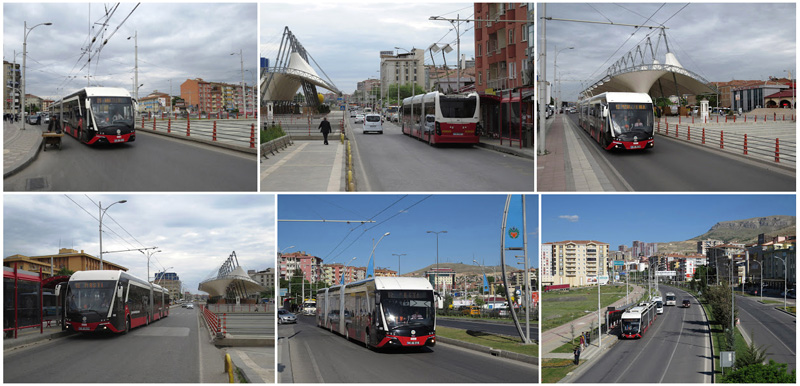



[as of 2016 ]
City
Founded:
~4000 BC
Population:
494 918 (2012)
Location:
Malatya
Network Stats
Operator: Motaş AŞ
System opened:
10.03.2015
Overhead length:
43,0 km. (one-way)
Number of routes:
1
Vehicles:
9
Vehicles needed for service:
9
Network map:
2016
Trambüs official timetable (not observed):
2016
Trambüs actual operating schedule:
2016
The TramBüs trolleybus line operates between the Maşti Otogar (Bus Station) in the west of the city, and the suburban İnönü Üniversitesi campus in the east. The line traverses the city west – east via the main semi-highway thoroughfare. The eastern segment of the line via the Malatya - Elazığ highway D300 is of an interurban character. The line boasts impressive views amid mountainous vistas. The trolleybus line was built as a cheaper alternative to the light rail. However, it is not a trolleybus BRT line, but rather a classic trolleybus. The entire line operates in a mixed traffic mode. Some added features are limited to no-parking signs along curbsides, no stopping zones for dolmuşes (route taxis) near TramBüs stops, and pre-boarding fare collection at turnstiles at busy stops. The fare is paid to a driver at minor stops. Some stops are spaced rather closely, only a few hundred meters apart. All stops are made on request. The trolleybus line is duplicated by multiple diesel bus and dolmuş services. The route designation for westbound trips is 12, and for eastbound trips is 21.
The official TramBüs schedule is publicized on Motaş website, but it is never observed. Moreover, count down clocks at stops never work. A 10 min headway was officially announced upon system's opening in 2015. Unfortunately, vehicle 4407 burned down soon after, and a replacement has not arrived yet. On weekdays the entire fleet of remaining 9 trolleybuses is pressed into service, operating with an actual 11 min headway. On weekdays during daytime and on weekends the headway is 12 min., which is lower then the officially scheduled headway.
The TramBüs service is highly unreliable and inefficient. On weekdays trolleybuses operate severely crushloaded at all times. The service is also affected by some traffic jams. The headway is unpredictable, as vehicle bunching is rampant. Weekday observations yielded trolleybuses operating anywhere between every 1 to 23 min. There are no visible efforts to fix service consistency. This would be impossible anyway due to a short recovery time at the western terminal, no layover in the east of the line, and no spare vehicles available. Overall, the service deficiencies are mostly due to a severe shortage of rolling stock, limited capacity of trolleybuses as a mode, and interference with other traffic.
A trolleybus depot was opened at the western end of the line in the spring of 2016, a year after the opening of the system. Before that trolleybuses were stored at a temporary facility next to the Motaş office in the north of the city, which they accessed in a diesel auxiliary power mode. On weekends all trolleybuses go through a routine maintenance one by one, for a few hours each. A revenue trolleybus continues from the Maşti Terminal into the depot, where a replacement vehicle awaits. A driver quickly switches between vehicles, and pulls back into service with another trolleybus.
Rolling Stock
Bozankaya Vossloh Kiepe
9 vehicles delivered in 2014 (4401-4406, 4408-4410)
9 three-section articulated trolleybuses with diesel auxiliary power option were built by the Turkish Bozankaya factory, using electric equipment by Vossloh Kiepe. The 10th vehicle 4407 burned down 5 days after the opening of the system.
Photos
Last updated:
15-May-2016
© 2002 Author: Yury Maller - Usage of material found herein for public display is possible with authors' permission only.